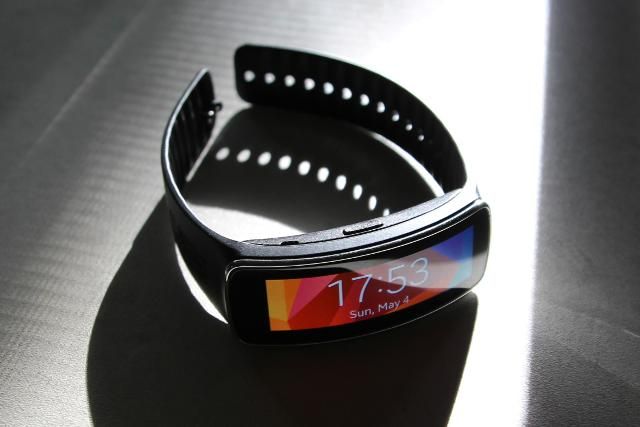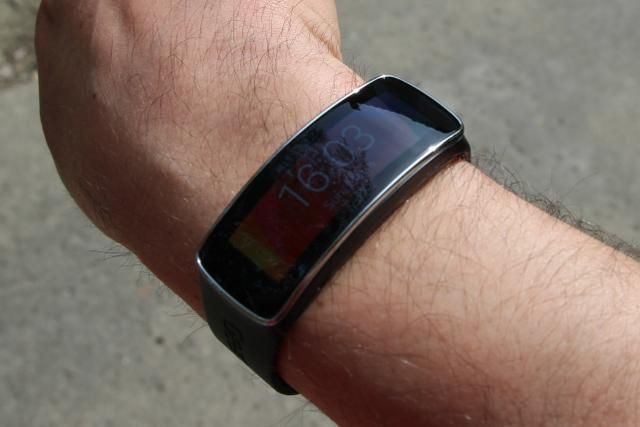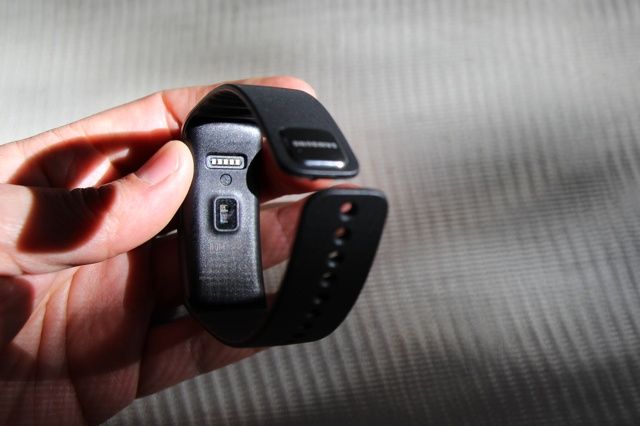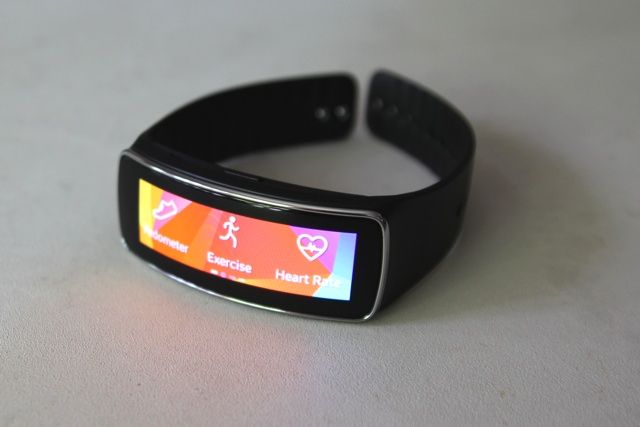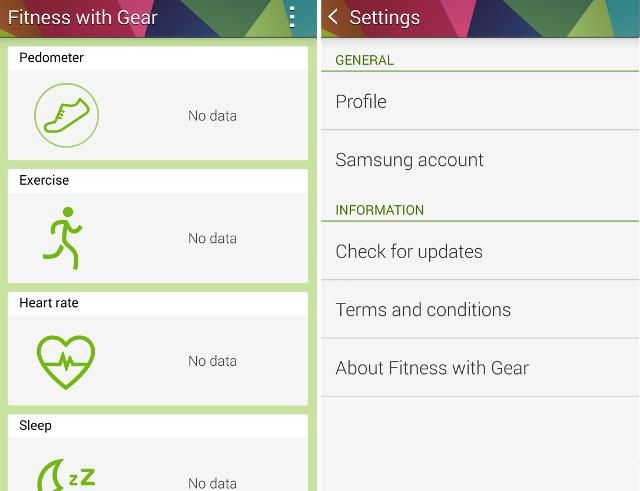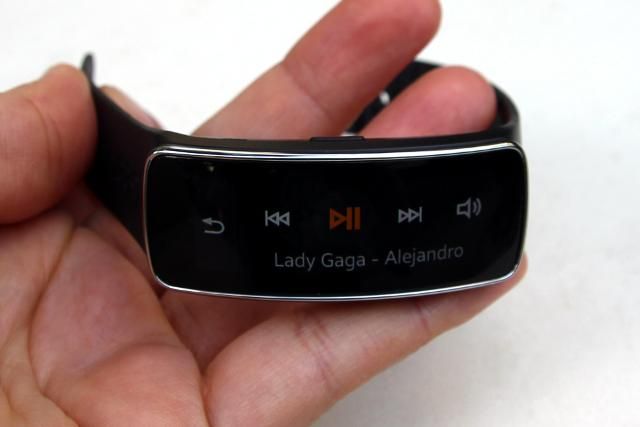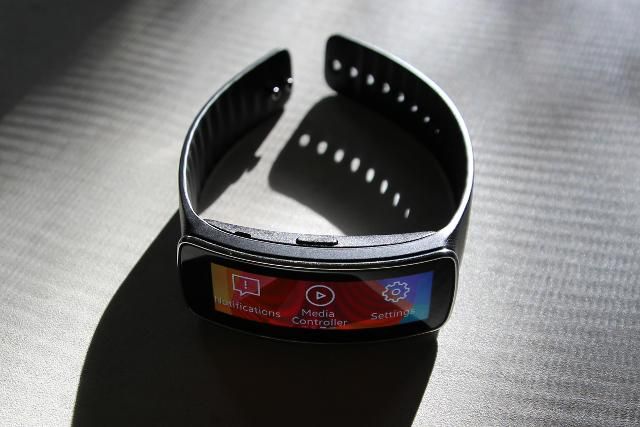Samsung's Gear Fit enters a smartwatch arena filled with blood thirsty, formidable competition. Their previous entry into the fray, the Galaxy Gear, offered notifications only – the Fit provides a hybrid of notifications and exercise-oriented features.
With the majority of smartwatches offering either notifications or health metrics, a smartwatch offering both fulfills an almost untouched niche. While relatively novel, does the $200 Gear Fit match other wearables such as the $199 Basis Health Tracker (our Basis review), the Pebble smartwatch (our Pebble review) or the $199.99 Sony SmartWatch 2 (Sony SmartWatch 2 review)? It's certainly among the more affordable of smartwatches, but does it provide a healthy middle ground between fitness watches and notifications watches? Read on to find out.
What's a Smartwatch?
Smartwatches classify as "wearable tech", a term coined at the Consumer Electronics Show in 2013. In a nutshell, wearables come in the physical form of a watch, while providing some kind of computer-like function. They tend to fulfill one of two niches: fitness tracking or smartphone notifications. Most fitness-oriented devices provide the user with information on their biometric readings — such as heart rate or the number of foot steps taken (pedometer). Notification watches replicate notifications from a smartphone to the display of the smartwatch. The Gear Fit provides a little bit of both worlds.
Initial Impression
The Samsung Gear fit looks and feels like a quality, although mostly plastic, device.
Unboxing
Unboxing the Gear Fit doesn't take long. I popped open the faux-wood colored box and inside lay the watch, a proprietary connector, instruction manual and a microUSB charger. Samsung exercised good design judgement in using a microUSB connector for the cradle, so one can charge either from a computer or from an AC adapter.
Design
The Samsung Gear Fit offers a stylish, but plasticky, build. The weight and heft feel incredibly light. Like most Samsung devices it fuses sleek curves with textured, black plastic. The band feels uncomfortable at first – rather than using softer silicone rubber, the Fit's plastic band uses a crosshatched texture, making it easy to grip. Connected to the band, the Fit's display features a curved, 1.84" 432 x 128 AMOLED screen. Its colors at maximum brightness shine in a vibrant and beautiful splendor. Even within the saturated, fitness oriented smartwatches market, few competitors come close to matching it. While readable in direct sunlight, the display's outdoor mode won't glow with the same beauty as it does indoors.
After powering the Fit on, a tiny linear motor shudders, vibrating the entire device. The Samsung logo then splashes across the rectangular watch-face in a boot process taking approximately 9 seconds. The rear of the device houses the sensor, which emits a green beam of light, scanning the user's heartbeat when active. Above it rests five square studs, which the charging cradle connects to.
Specifications
- 1.84-inch curved Super AMOLED touchscreen display
- IP67 water and dust-proofing certification
- Accelerometer, gyroscope and heart rate sensor
- 3-4 days of use with normal activity; 5 days with low usage
- Bluetooth 4.0 LE (low energy Bluetooth)
- Gorilla Glass 3
Pairing Process
For anyone with a compatible Samsung device, the pairing process only requires downloading and installing Samsung's Gear Fit Manager app (available in the Samsung Market). However, in order to receive analysis of your health metrics, you'll also need to install the Fitness with Gear application. Both come directly from Samsung's App Store, which requires owning a Samsung device. For those of you without a Samsung smartphone or tablet, it's technically possible to pair with the Fit. However, doing so requires a bit of hacking – XDA Junior Member, nala1908, figured out how to get the Gear Fit working with several other devices, in particular, the Nexus 5 (our Nexus 5 review). You can find a complete list of instructions on XDA Developers in the original thread. It's important to note that you can also acquire copies of the Gear Manager software and Samsung's S-Health app from third party sources – however, these carry a significant amount of risk, as third party apps can contain malware.
Living with the Samsung Gear Fit
The Gear Fit offers three primary features – first, it offers health metrics on its user, such as heart rate and a pedometer, which tracks steps taken. Second, it offers notifications from your smartphone. Third, you can control some apps on your smartphone or tablet. It should be noted that Samsung has locked the Fit to a select number of Samsung tablets and smartwatches (here's a complete list of Samsung devices compatible with the Gear Fit).
The Gear Fit's blend of notifications along with health metrics appears to fulfill a highly useful niche within the wearables market. However, in practice, the device excels at neither function. In particular, the Fit suffers from serious usability issues for tracking health metrics. The notification features are also similarly plagued – however, the Fit worked great for locating my smartphone.
Health Metrics
The Gear Fit offers three kinds of health metrics – pedometer (includes jogging, hiking and walking), cycling distance and heart rate monitor. I tested the reported figures against the purely health-oriented Basis Health Tracker. On the positive side, the Gear Fit gave similar readings which we can safely assume are accurate. The accompanying suite of apps (Fitness with Gear, Gear Fit Manager and S Health) can log and track more information, including sleep metrics. Unfortunately, the features available in Fitness with Gear require a Samsung account, which I couldn't access as I own a Nexus 5.
For all four fitness tracking features, the Fit requires manually initiating each activity. In order to track my own jogging distance, I had to turn on the Fit, find the Exercise feature, then enable the jogging tracker. For comparison, the Basis Health Tracker automates this process, automatically detecting when a run begins and ends. The Fit isn't alone in requiring manual activation, but it's still tedious. The cycling distance tracker requires GPS from a paired smartphone or tablet. This causes problems if you work out inside of a gym using a stationary bicycle, as well as incurring additional battery drain. When I wasn't able to bring my phone along when bicycling, the Fit simply wouldn't function correctly. Samsung made a poor call by using the GPS for distance tracking as it forces the user to drag a phone with them while exercising – not everyone wants their phone with them while exposed to inclement weather or dust.
On one hand, it's useful for tracking your weekly workout statistics, since the data pairs with your smartphone over Bluetooth. On the other hand, the system doesn't compare favorably with competitors' products, though. For example, Basis's Health Tracker automatically logs and analyzes behavioral patterns. In short, the Fit absolutely fails at offering convenience and the data isn't particularly useful for workout nuts.
Sleep Tracking
Samsung's exercise logging software (Fitness with Gear), which you must download from the Samsung Market, offers a total record of your exercise and sleeping habits. It also includes a feature which tracks sleep data.
The sleep tracking portion of the app only gives two data points: Total time spent sleeping and the amount of time spent motionless. To access this information, you are required to create a Samsung account. Judging from the scant few reviews that covered the Fit's sleep tracking feature, it appears to not really offer practical value. It's just a meaningless statistic compared to competitors' sleep analysis tools. Those who want a more sophisticated sleep tracking device, look elsewhere.
Notifications
The Gear Fit by default only provides notifications from email, SMS, alarms, calls and the weather. After bit of configuring through the Gear Fit Manager app, the Fit can also receive notifications from any app. However, you must individually select each application. After enabling notifications for RSS, and instant messengers, I can confirm that it works as advertised. On the downside, it's difficult finding and enabling third-party app notifications within the Gear Fit Manager. There's several steps involved and none seem very well laid out or obvious.
Music Control
My favorite feature is the music app, which works with the the native music player of your phone. You can pause songs, adjust volume and skip tracks. This is quite useful for those who don't want to pull their phone out to listen to music.
Phone Locator
Ever misplace your phone? If it's anywhere within Bluetooth range, the Fit can fire up the phone's ringtone. It will play until the user cancels the app on the smartphone or on the Gear Fit. Overall, this feature makes finding one's phone much easier. The great thing about the phone finder is its ability to ring it, even if the volume has been disabled or silenced.
Finding my phone with the Fit didn't require much effort. Simply activating the locator feature in the smartwatch automatically turns on the ringtone for the phone, even if muted. On the downside, falling outside of Bluetooth range will break Bluetooth pairing, requiring re-establishing the connection – but that's impossible unless you actually have the phone in hand. I found that with several walls in the way, the range is about 20 feet.
Should You Buy the Samsung Gear Fit?
Not everyone should run out and buy wearable tech. Should you buy a smartwatch? Right now, most devices offer either health or fitness oriented tracking: the Fit offers both, but does neither well. While it does offer an interesting and useful feature in locating missing smartphones, it fails in most other respects. However, I feel it's necessary to mention that the display is absolutely gorgeous and eye-catching. It packs enough interesting features, such as the ability to control music, that the Fit will impress at first glance. For those (who own compatible Samsung devices) wanting a shallow, yet gorgeous, smartwatch that offers both notifications and fitness tracking, the Gear Fit will satisfy. For those wanting a more practical and useful device, the Fit falls flat on its watch-face.
[recommend]MakeUseOf recommends: Don't buy it. For some users access to health metrics and notifications in a $200 package is exactly what they're looking for. For the rest of us, buy a device dedicated to either one or the other.[/recommend]
How do I win the Samsung Gear Fit?
You may enter by submitting your name and email address. You'll receive one entry simply by doing so.
After that, you'll also be offered various methods to earn additional entries. They range from sharing a link to this giveaway on social networks; to commenting or visiting a specific page. The more you participate, the higher your chances of winning! You will receive 5 additional entries into the giveaway for every successful referral via your shared links.
This giveaway begins now and ends Friday, 23rd May. The winner will be selected at random and informed via email. View the list of winners here.
The Winner
Congratulations, Lisa Castellanos! You would have received an email from jackson@makeuseof.com. Please respond before June 11 to claim your prize. Enquires beyond this date will not be entertained.
Send your products to be reviewed. Contact Jackson Chung for further details.


